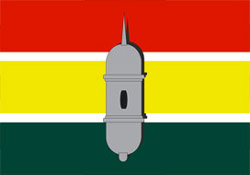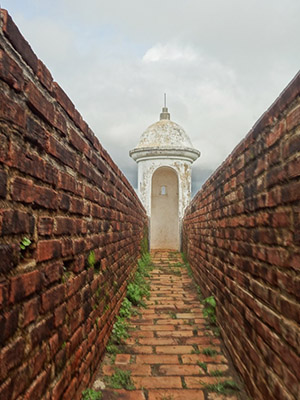 |
Fortaleza de
São José de Macapá
Macapá, Brazil
|
|
 |
Constructed: 1764 - 1782
Used by: Portugal, Brazil
Conflict in which it participated:
None
|
Thank you, Portugal. Without you, who would have built starforts in South America in the 18th century? Well, Spain, probably. But somehow, your starforts are nicer.
In 1544, Spanish explorer and conquistador Francisco de Orellana (1511-1546) claimed the region where Macapá would later be established. Orellana was known for being the first European to navigate the entire Amazon River (1541-1542), and was given permission by the Spanish crown to conquer the lands he had discovered. He must not have done a very thorough job, however, because it was the Portuguese who ultimately settled this region.
|
 |
|
|
In 1738, a Portuguese military base was thereupon established, and someone noticed that there were a multitude of bacabas, a fruit vaguely reminiscent of an avocado, hanging from the picturesque palm trees. The town of Macapá was officially established in 1758, its name a corruption of a Tipi word, macapaba, "land of many bacabas." But let us now move on from this fascinating saga of little fruits.
Macapá was obviously felt to be a highly strategic point indeed, as several earlier fortifications had existed there before the Fortaleza of our current interest, each built atop the ruins of the last. The previous fortifications were as follows:
|
|
|
|
Macapá is sometimes called "the capital of the middle of the world," because the equator passes through the town. As such, one can imagine the difficulties involved in building and maintaining anything more substantial than a bamboo hut: This is why so many forts came and went so swiftly at Macapá.
|
Money shot! With a grand total of eight, the Fortaleza de
São José de Macapá may have more garitas than any other starfort. |
 |
The Fortaleza was named for Saint Joseph, Jesus' dad and patron saint of workmen. The workmen responsible for building the Fortaleza were the primary reason that it took 18 years to build: The African slaves insisted on escaping, and the indigenous workers insisted on dying of malaria. When the lazy workers did finally get around to finishing the Fortaleza in 1782, it mounted over 60 guns and, more importantly, eight garitas!! These are of course the pretty white turrets that grace the tips of the corner bastions on many a Portuguese and Spanish starfort of this era.
|
|
While the garita is by no means an unusual feature on a starfort, the Fortaleza de São José de Macapá could very well be the world leader in number of garitas on a single fort. It has one at each bastion tip, but also one in the center of each curtain wall, save for the landward-facing, western wall, which is protected by the Ravelin (which also has a garita at its leading edge). Each bastion mounted fourteen cannon, with another eleven in the Ravelin.
|
Brazil gained its independence from Portugal in 1824. The new Empire of Brazil was a bit of a shambles for many years, and the Fortaleza de São José was mostly left to its own deteriorating devices for the next couple of decades.
Finally in 1847 the War Office remembered that it had a starfort at Macapá and sent a crew to determine the state of the Fortaleza. They found it stoutly built but pretty much abandoned, to the degree that local farmers were corraling their livestock inside the fort's walls.

Sick of garitas yet? I'm not! The official flag of the city of Macapá has a garita right there in the center! |
 |
The Ravelin was crumbling and overgrown, the drawbridge had collapsed and a soldier had apparently fallen into the cistern, making this source of drinking water if not useless, at least extremely distasteful. Way to go there, soldier. |
|
 |

One would no doubt feel snug, secure and protected as one crawled into one's garita. |
|
By the time advances in the naval and artilleral arts rendered starforts obsolete at the end of the 19th century, the Fortaleza de São José had served its purpose well, deterring anyone from making hostile advances into the Amazon for over a century.
At the beginning of the 20th century, the Brazilian Navy installed a steel tower in the Fortaleza's southeast bastion. It had a searchlight atop, and served to aid navigation at the Amazon River's north bar.
|
| The Fortaleza in 1960, serving its primary role as a military social club. Looks fun. Note the sorrowful condition of the Ravelin to the left. |
 |
Through the 20th century, the Fortaleza de São José was used as a prison, a military social club, a place to house immigrants and displaced persons, and various other things that I can't really determine due to the weird translation I'm reading. In 1950 there were still 54 cannon of various calibers lying around the Fortaleza.
Toward the end of the 20th century, everybody in Brazil agreed that it would be really cool to restore the Fortaleza of our current interest, but nobody could manage to get off their duffs and start shoveling dirt and rearranging bricks until 1999. Today the Fortaleza de São José is in lovely restored condition open as a public park.
|
|
One recent visitor to the Fortaleza noted that there is "bizarrely little in the way of plaques or information" there. This approach would make sense if there were intended to be plenty of interprative guides skulking about, ready to blab at length about the Fortaleza. This is the case at Fort Clinch in Florida, but I've seen nothing to make me think that there are lots of dudes dressed up as conquistadors, escaping African slaves and/or feverish indiginous workers hanging around the Fortaleza, waiting to explain things. |
|
|
|
|
|
 |




